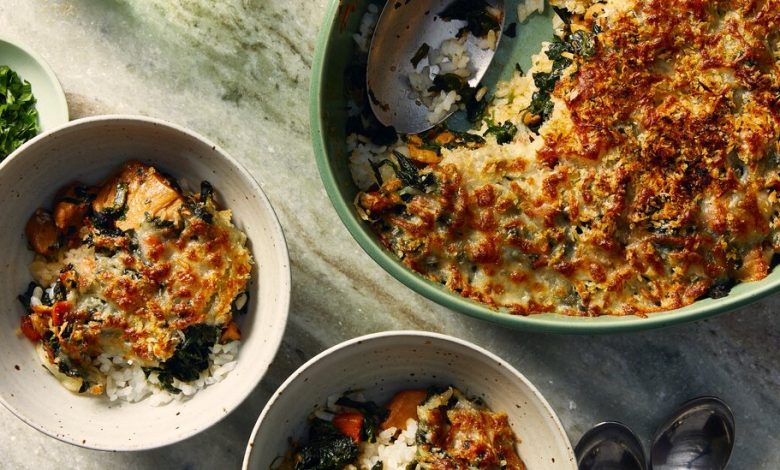The Comforting, Cheesy Charm of Chicken Doria

Doria entered my life on a roundabout occasion in Japan: After an evening drag show in Osaka’s Doyama district, striking out on a date and stumbling into a convenience store, I reached into a freezer for the first available package. I wanted immediate nourishment; naturally, I grabbed a dish that needed cooking. So it wasn’t until I ambled back to my rental that I could set the warm doria bowl on a plate.
Recipe: Chicken Doria
Melted mozzarella gelled with even chewier rice. Spice was present but hardly overbearing. Every bite yielded slices of moist chicken, tucked into the meal’s saucy folds, and layer after layer of flavor felt entirely unexpected but deeply welcome. It gradually woke me up to the realization of my luck — and I finished my doria on a patio overlooking the city, spooning up the remainder of the meal as dawn slumped overhead.
Another year passed before I ran into doria again, this time at a boyfriend’s apartment, navigating another revolution around the conversational constellation of dinner. For once, we weren’t keen on midnight breakfast tacos. All our Thai spots were closed. But we had leftover rice, milk for a roux and a pack of chicken thighs roughly 40 seconds from expiring. It probably wouldn’t take much effort to bring together a sauce, ladle that sauce over rice and get everything into the oven. Which is precisely what happened. Our first bites obliterated the question of how to use the fridge’s odds and ends for the next few months. While fanning our mouths from the still-steaming doria, we murmured, “Wow,” and “What the actual hell.”
More on Japan
- A Corruption Scandal: Japan’s prosecutors accused Dentsu, an advertising company that was one of the driving forces behind the 2020 Tokyo Olympics, of conspiring to evade the public bidding process leading up to the Games.
- A Video-Gaming School: Japan’s first e-sports high school thought it would turn out pro gamers. Instead, it attracted an unexpected demographic: absentee students.
- Economic Growth: After more than two years under some of the world’s tightest border controls, tourist spots in Japan are packed. That has been good for business.
- Yakuza on the Field: As Japan’s iconic gangster group faces a changed world and a waning appeal, a softball team is helping former members build a new life.
Doria’s construction is parallel to gratin, but the flavor profile varies from its Western cousin: a creamy, savory sauce (generally white or tomato, dealer’s choice) is blanketed over a bed of rice, which has been sautéed alongside carrots, onions and mushrooms. Once the chicken is in, your dish is then seasoned with tonkatsu sauce and Japanese hot mustard. If you’re going full tilt, the meal is topped with cheese broiled to a crisped, melty perfection.
Invented as a seafood dish in the 1930s, doria can now be found everywhere in Japan: from kissaten (traditional coffeehouses) to yoshoku diners (Western-style Japanese restaurants) to home kitchens.
In many ways, this is comfort food incarnate: bliss conjured briskly with whatever is already on hand. Consequently, doria is deeply amenable to flexibility: Obviously, the dish can be cooked with seafood, subbing prawns or scallops for the protein. Or you could opt for an entirely veggie-based casserole, leaning toward extra carrots and potatoes and spinach. Or if you’re in a bind, it can ultimately be condensed to six or seven ingredients that you’ll find in a reasonably stocked market.
It’s the dish I’m most likely to throw together for a hangout, nodding dumbly as I’m told that I really shouldn’t have gone to the trouble (except I didn’t). And whenever I’ve cooked the dish for others, the questions recur: Is it a gratin? (Mostly.) But it’s not Italian? (No.) Except it sounds Italian. (Eh.) But it’s an entirely different thing and also delicious? (Precisely.)
A couple of years back, in the midst of a Covid surge, my mother flew down to visit my old place in Texas. I wasn’t sure what to cook for her. I’d been working on edits to my most recent novel and eating, for convenience, in a curry udon vortex. But the loose ends would come together for a pretty decent doria. There were even opportunities to vary my usual recipe: spinach provided another component of texture, multiple cheeses made for a more complex bite. As I finished cooking the meal, plating the dish on pastel plates, it was a moment when many different timelines crashed together, even if I wouldn’t have described it as such then.
When you’re cooking doria — when you’re cooking anything — it’s worth thinking through the ways that your own history has melded with the recipe. As each ingredient touches your hands, its context is married with your own: My doria is queer potlucks and comfort and cushions. It’s a dish whose converging histories merge cleanly into your own. History can be like that, and recipes, too.
Still, language often eludes in the moment. But after a few bites of our doria, my mother asked where the recipe came from, which was another way of asking how, given seemingly infinite degrees of separation, I came across it. Which is only ever, really, the same kind of sentiment: This thing that means so much to you is now a part of me, and it now means a good deal to me, too.
